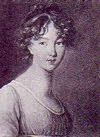This pattern comes from Weldon’s Practical Knitter,
Number 25, Seventh Series (1888). It is also published in Weldon’s Practical
Needlework, Volume 3, Interweave Press, 2000.
The original pattern calls for “ a small quantity of
lemon-coloured Andalusian wool and
of brown single Berlin” wool, and “a pair of steel knitting needles No. 14”
(modern equivalent 2mm/US 0.) Sateen, cardboard and black fabric to convert the
underside to a penwiper are needed to complete the cushion.
A brown square is knitted first. This piece is then
sewn over a circular cardboard piece which has previously been covered with the
sateen and slightly “raised (stuffed) in
front.” Two separate strips in yellow are next knit,“in imitation of the
petals” of the sunflower. These strips vary in the number of stitches to
produce different widths and are “join(ed)” and “pleat(ed) to the size of the
cushion” when sewn onto the first circular piece.
More sewing is required for the back of cushion – a
“circle of stout cardboard,” covered on both sides with “sateen,” and sewn onto
the sunflower. “Three circular pieces of black cloth for a penwiper” are then
sewn onto the back circle. Not finished yet, the pattern suggests that a
“ribbon” can be “attached (to it) to
hang it up by.” Conversely, or if the person making this pincushion has felt
enough energy has been spent on the project, the “pincushion can lie on the
drawing-room table.”
I knit this
pincushion/penwiper on the suggested size of needles, using Knit Picks Palette
in Semolina and Bison. I did not put enough stuffing in the first circle so the
pincushion part was rather flat, especially with the brown knitted part
securely sewn onto the cardboard circle. To remedy this, I changed the pattern
– something I have rarely, if ever, done in making more than forty
reproductions from Weldon’s patterns. I discarded the two cardboard circles,
and opened out and stuffed the brown section, now in its original shape of a
square, adding a black felt bottom layer. I then sewed the square under the
petals. Before doing that, I had sewn another piece of black felt onto the
bottom of the square, creating a pocket for wiping the nibs of pens. I have
also considered stitching a few more squares of black felt to the back as extra
wiping cloths.
The pincushion measures
5 ½” in width, outer point to outer point and the black felt section on the
reverse side is just over 3” square. The petals, in spite of blocking, do not
lie flat on the drawing-room table or my desk or anywhere for that matter.
All
quotations are from Weldon’s Practical Needlework, Volume 3,
Interweave Press, 2000





No comments:
Post a Comment